Ahmed Baruwa
BLOOM+1: Adding Language Support to BLOOM for Zero-Shot Prompting
Dec 19, 2022



Abstract:The BLOOM model is a large open-source multilingual language model capable of zero-shot learning, but its pretraining was limited to 46 languages. To improve its zero-shot performance on unseen languages, it is desirable to adapt BLOOM, but previous works have only explored adapting small language models. In this work, we apply existing language adaptation strategies to BLOOM and benchmark its zero-shot prompting performance on eight new languages. We find language adaptation to be effective at improving zero-shot performance in new languages. Surprisingly, adapter-based finetuning is more effective than continued pretraining for large models. In addition, we discover that prompting performance is not significantly affected by language specifics, such as the writing system. It is primarily determined by the size of the language adaptation data. We also add new languages to BLOOMZ, which is a multitask finetuned version of BLOOM capable of following task instructions zero-shot. We find including a new language in the multitask fine-tuning mixture to be the most effective method to teach BLOOMZ a new language. We conclude that with sufficient training data language adaptation can generalize well to diverse languages. Our code is available at \url{https://github.com/bigscience-workshop/multilingual-modeling/}.
BLOOM: A 176B-Parameter Open-Access Multilingual Language Model
Nov 09, 2022Abstract:Large language models (LLMs) have been shown to be able to perform new tasks based on a few demonstrations or natural language instructions. While these capabilities have led to widespread adoption, most LLMs are developed by resource-rich organizations and are frequently kept from the public. As a step towards democratizing this powerful technology, we present BLOOM, a 176B-parameter open-access language model designed and built thanks to a collaboration of hundreds of researchers. BLOOM is a decoder-only Transformer language model that was trained on the ROOTS corpus, a dataset comprising hundreds of sources in 46 natural and 13 programming languages (59 in total). We find that BLOOM achieves competitive performance on a wide variety of benchmarks, with stronger results after undergoing multitask prompted finetuning. To facilitate future research and applications using LLMs, we publicly release our models and code under the Responsible AI License.
Ìtàkúròso: Exploiting Cross-Lingual Transferability for Natural Language Generation of Dialogues in Low-Resource, African Languages
Apr 17, 2022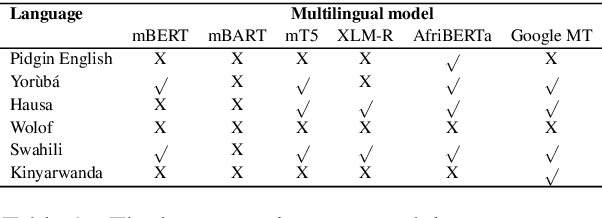
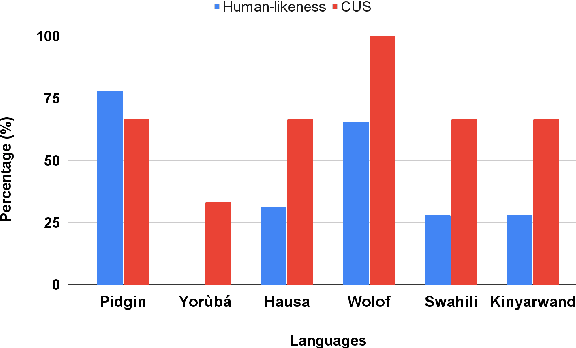
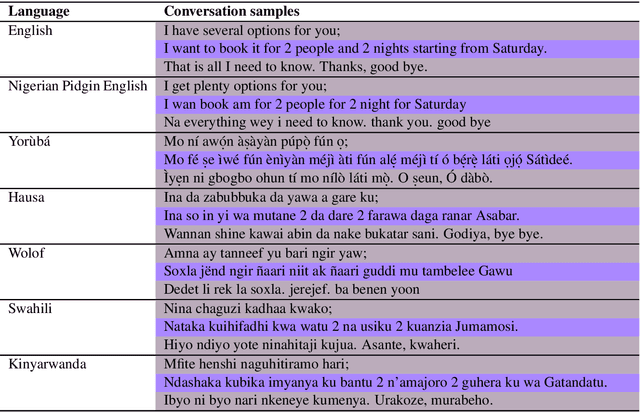
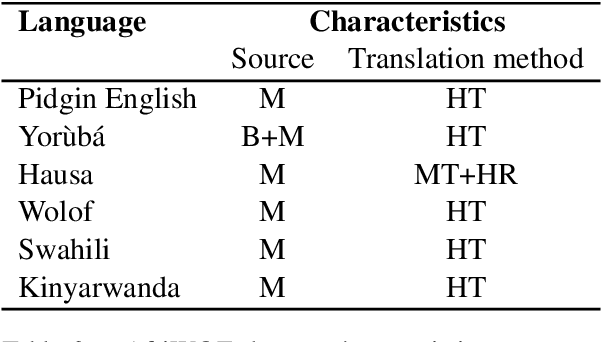
Abstract:We investigate the possibility of cross-lingual transfer from a state-of-the-art (SoTA) deep monolingual model (DialoGPT) to 6 African languages and compare with 2 baselines (BlenderBot 90M, another SoTA, and a simple Seq2Seq). The languages are Swahili, Wolof, Hausa, Nigerian Pidgin English, Kinyarwanda & Yor\`ub\'a. Generation of dialogues is known to be a challenging task for many reasons. It becomes more challenging for African languages which are low-resource in terms of data. Therefore, we translate a small portion of the English multi-domain MultiWOZ dataset for each target language. Besides intrinsic evaluation (i.e. perplexity), we conduct human evaluation of single-turn conversations by using majority votes and measure inter-annotator agreement (IAA). The results show that the hypothesis that deep monolingual models learn some abstractions that generalise across languages holds. We observe human-like conversations in 5 out of the 6 languages. It, however, applies to different degrees in different languages, which is expected. The language with the most transferable properties is the Nigerian Pidgin English, with a human-likeness score of 78.1%, of which 34.4% are unanimous. The main contributions of this paper include the representation (through the provision of high-quality dialogue data) of under-represented African languages and demonstrating the cross-lingual transferability hypothesis for dialogue systems. We also provide the datasets and host the model checkpoints/demos on the HuggingFace hub for public access.
Quality at a Glance: An Audit of Web-Crawled Multilingual Datasets
Mar 22, 2021
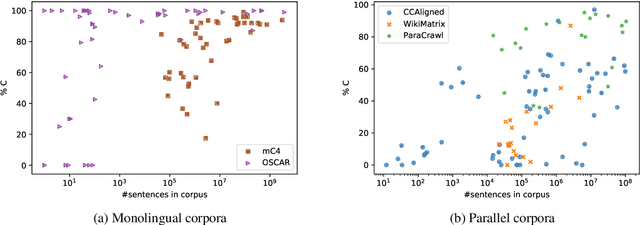
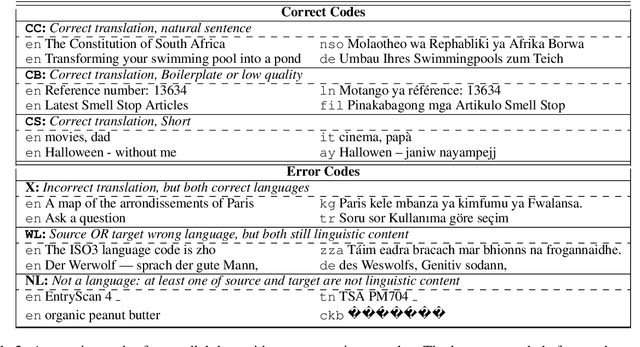
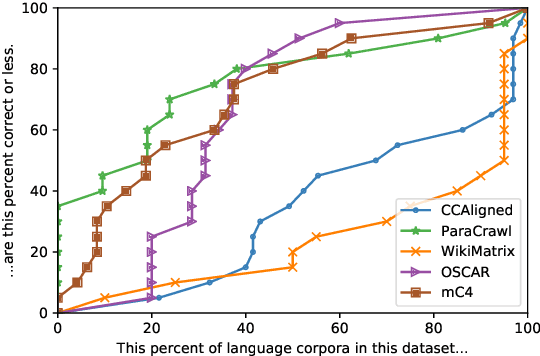
Abstract:With the success of large-scale pre-training and multilingual modeling in Natural Language Processing (NLP), recent years have seen a proliferation of large, web-mined text datasets covering hundreds of languages. However, to date there has been no systematic analysis of the quality of these publicly available datasets, or whether the datasets actually contain content in the languages they claim to represent. In this work, we manually audit the quality of 205 language-specific corpora released with five major public datasets (CCAligned, ParaCrawl, WikiMatrix, OSCAR, mC4), and audit the correctness of language codes in a sixth (JW300). We find that lower-resource corpora have systematic issues: at least 15 corpora are completely erroneous, and a significant fraction contains less than 50% sentences of acceptable quality. Similarly, we find 82 corpora that are mislabeled or use nonstandard/ambiguous language codes. We demonstrate that these issues are easy to detect even for non-speakers of the languages in question, and supplement the human judgements with automatic analyses. Inspired by our analysis, we recommend techniques to evaluate and improve multilingual corpora and discuss the risks that come with low-quality data releases.
Leveraging End-to-End Speech Recognition with Neural Architecture Search
Dec 11, 2019



Abstract:Deep neural networks (DNNs) have been demonstrated to outperform many traditional machine learning algorithms in Automatic Speech Recognition (ASR). In this paper, we show that a large improvement in the accuracy of deep speech models can be achieved with effective Neural Architecture Optimization at a very low computational cost. Phone recognition tests with the popular LibriSpeech and TIMIT benchmarks proved this fact by displaying the ability to discover and train novel candidate models within a few hours (less than a day) many times faster than the attention-based seq2seq models. Our method achieves test error of 7% Word Error Rate (WER) on the LibriSpeech corpus and 13% Phone Error Rate (PER) on the TIMIT corpus, on par with state-of-the-art results.
 Add to Chrome
Add to Chrome Add to Firefox
Add to Firefox Add to Edge
Add to Edge